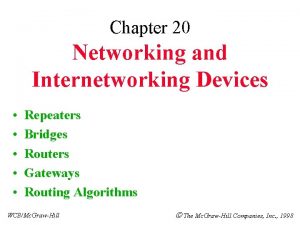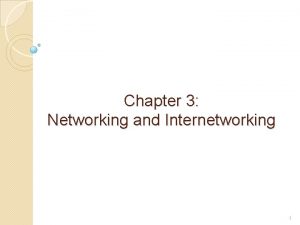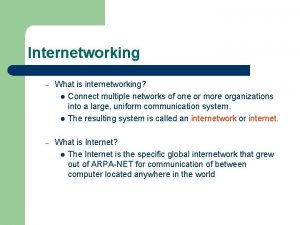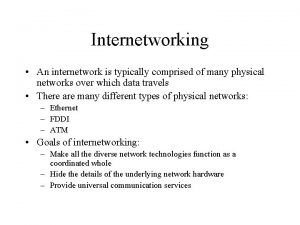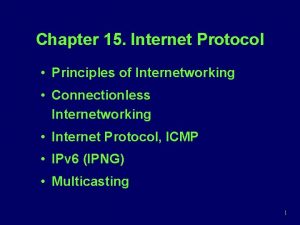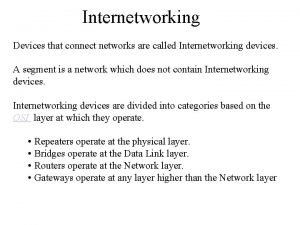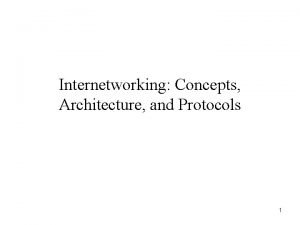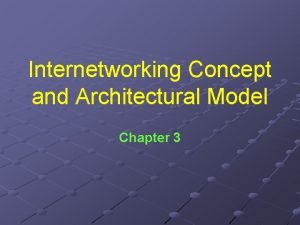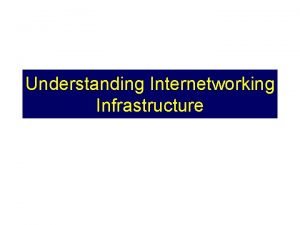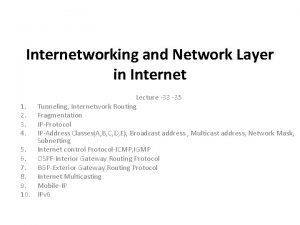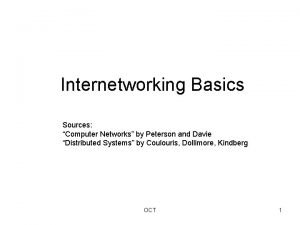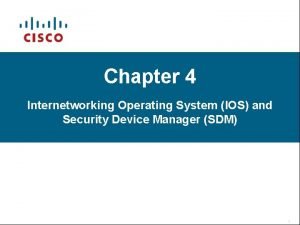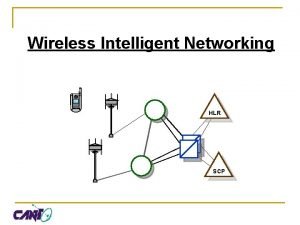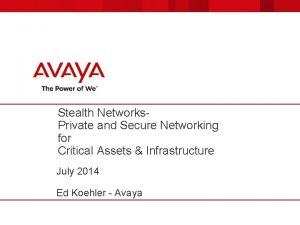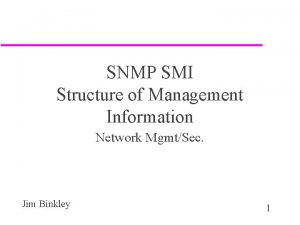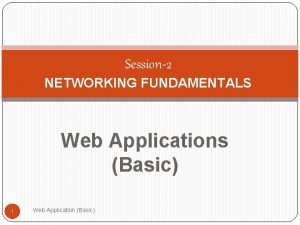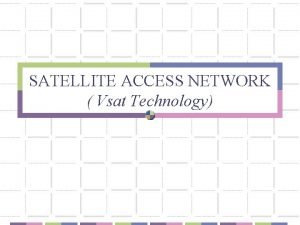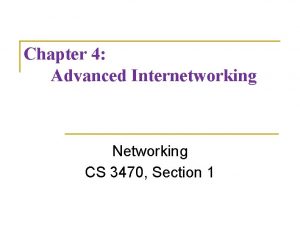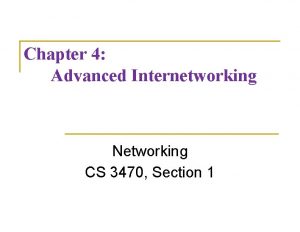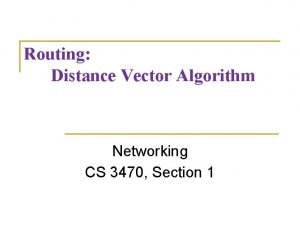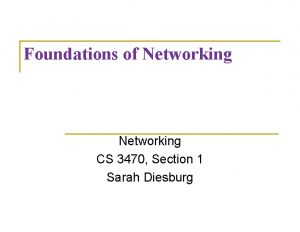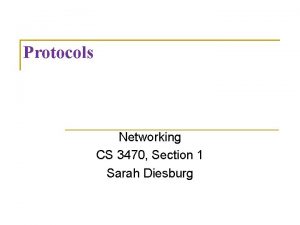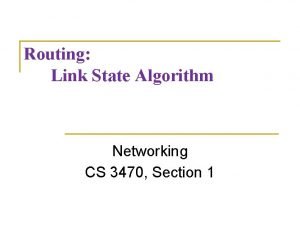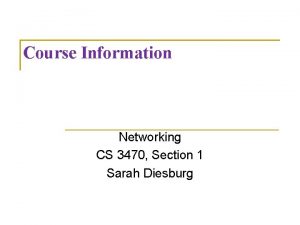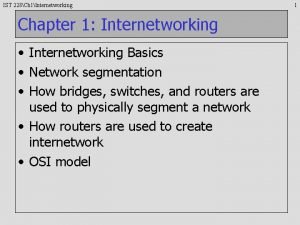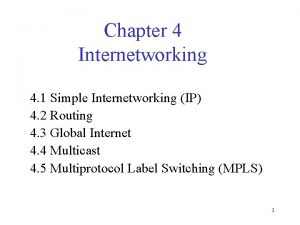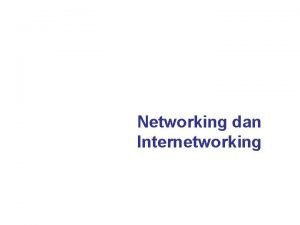Chapter 4 Advanced Internetworking Networking CS 3470 Section









![OSPF LSA types Router link advertisement [Hello message] Network link advertisement Network summary link OSPF LSA types Router link advertisement [Hello message] Network link advertisement Network summary link](https://slidetodoc.com/presentation_image_h/24ecc21625e85397165f574b47ba04d5/image-10.jpg)
























- Slides: 34

Chapter 4: Advanced Internetworking Networking CS 3470, Section 1

Intra-AS and Inter-AS Routing C. b a C Gateways: B. a • perform inter-AS A. a b A. c A d a b c a c B b routing amongst themselves • perform intra-AS routers with other routers in their AS

Intra-AS and Inter-AS Routing C. b a C Gateways: B. a • perform inter-AS A. a b A. c A d a b c a c B b routing amongst themselves • perform intra-AS routers with other routers in their AS network layer inter-AS, intra-AS routing in gateway A. c link layer physical layer

Intra-AS Routing Algorithms We have already talked about two intra-AS routing algorithms: Link state routing Distance vector routing

Link State vs Distance Vector Tells everyone about neighbors Tells neighbors about everyone Controlled flooding to exchange link state Exchanges distance vectors with neighbors Dijkstra’s algorithm Bellman-Ford algorithm Each router computes its own table Each router’s table is used by others May have oscillations May have routing loops 5

RIP � RIP == Routing Information Protocol � RIP is a distance vector implementation (network_address, distance) pairs � Instead of advertising costs to the next router, RIP advertises the cost to the next network.

OSPF One of the most widely-used link-state routing protocols is Open Shortest Path First Open, nonproprietary standard created by the Internet Engineering Task Force Shortest Path First is an alternative name for linkstate routing Hierarchical – can divide the system into “areas. ” 7

OSPF Roles Internal router : : a level 1 router. Backbone router : : a level 2 router. Area border router (ABR) : : a backbone router that attaches to more than one area. AS border router : : (an interdomain router), namely, a router that attaches to routers from other ASs across AS boundaries.

OSPF advertisement Indicates LSA type Indicates link cost
![OSPF LSA types Router link advertisement Hello message Network link advertisement Network summary link OSPF LSA types Router link advertisement [Hello message] Network link advertisement Network summary link](https://slidetodoc.com/presentation_image_h/24ecc21625e85397165f574b47ba04d5/image-10.jpg)
OSPF LSA types Router link advertisement [Hello message] Network link advertisement Network summary link advertisement AS border router’s summary link advertisement AS external link advertisement

Inter-AS Routing (a. k. a Large Routing) BGP – Boarder Gateway Protocol 11

Border Gateway Protocol and Autonomous Systems Assumes the Internet is an arbitrarily interconnected set of AS's. Define local traffic as traffic that originates at or terminates on nodes within an AS, and transit traffic as traffic that passes through an AS.

Border Gateway Protocol and Autonomous Systems We can classify AS's into three types: Stub AS: an AS that has only a single connection to one other AS; such an AS will only carry local traffic 13

Border Gateway Protocol and Autonomous Systems We can classify AS's into three types: Multihomed AS: an AS that has connections to more than one other AS, but refuses to carry transit traffic 14

Border Gateway Protocol and Autonomous Systems We can classify AS's into three types: Transit AS: an AS that has connections to more than one other AS, and is designed to carry both transit and local traffic (backbone provider) 15

BGP The goal of Inter-domain routing is to find any path to the intended destination that is loop free We are concerned with reachability than optimality Finding path anywhere close to optimal is considered to be a great achievement

BGP Scalability: An Internet backbone router must be able to forward any packet destined anywhere in the Internet Autonomous nature of the domains Issues of trust

BGP Each AS has: One BGP speaker that advertises: local networks other reachable networks (transit AS only) gives path information In addition to the BGP speakers, the AS has one or more border “gateways” which need not be the same as the speakers The border gateways are the routers through which packets enter and leave the AS

BGP does not belong to either of the two main classes of routing protocols (distance vectors and link-state protocols) BGP advertises complete paths as an enumerated lists of ASs to reach a particular network

IPv 6 Moving on to IPv 6! For more information, refer to Section 4. 1. 3 in your textbooks 20

Why not IPv 4? IPv 4 addresses have become relatively scarce NATs help by promoting reuse of address space, but they don’t do enough

Why not IPv 4? The public IPv 4 address space will eventually be depleted. It would be nice to not have to rely on protocols like DHCP to configure addresses 22

Why not IPv 4? Private communication over a public medium like the Internet requires encryption services that protect the data being sent from being viewed or modified in transit.

Why IPv 6? IPv 6 is required to include IPsec allows authentication, encryption, and compression of IP traffic.

Why IPv 6? IPv 6 uses a 128 -bit address instead of the 32 -bit address of IPv 4. This doesn't give 4 times the addresses of IPv 4 but rather the number of IPv 4 addresses squared twice. A couple of articles out there have stated that this works out to billions of addresses for every square meter on the planet.

IPv 6 Addressing An IPv 6 address is written as hexadecimal values (0 -F) in groups of four separated by colons, like: A 223: BB 34: 0000: 0099: DA 78: 5679 Strings of zeros can be dropped and leading zeros in a number group can be dropped, so the example above would shorten to A 223: BB 34: : 99: DA 78: 5679.

IPv 6 Addressing IPv 4 isn't left out completely IPv 4 addresses can be expressed in IPv 6 form as follows: 0000: 0000: 192. 168. 10 –which can be shortened to : : 192. 168. 10 This makes transitioning a bit easier.

IPv 6 adds significant extra features that were not possible with IPv 4. Automatic configuration of hosts (similar and DHCP) Extensive multicasting capabilities Built-in security using authentication headers and encryption Built-in support for QOS and path control

IPv 4 and IPv 6 Headers

IPV 4 and IPV 6 Addressing Ipv 4: 32 bits ~ 4, 200, 000 addresses IPV 6 128 bits 340, 282, 366, 920, 938, 463, 374, 607, 431, 768, 211, 456 nodes Addresses have “scope” Addresses have lifetime Link Local Unique Local Global Valid and preferred lifetime facets Unicast, Multicast, and Anycast. . . but no broadcast

IPv 6 Addressing Same “longest-prefix match” routing as IPv 4 CIDR e. g: 2001: db 8: 12: : /40 The idea behind having fixed-width, 64 -bit wide host identifiers is that they aren't assigned manually as in IPv 4. Instead, v 6 host addresses are recommended to be built from so-called EUI 64 addresses.

IPv 6 Addressing EUI 64 addresses are 64 -bits wide, and derived from MAC addresses of the underlying network interface. For example, with Ethernet, the 6 -byte (48 bit) MAC address is usually filled with the hex bits "fffe" in the middle

What's your address, MAC? For example, with Ethernet, the 6 -byte (48 -bit) MAC address is usually filled with the hex bits "fffe" in the middle -- the MAC address 01: 23: 45: 67: 89: ab results in the EUI 64 address 01: 23: 45: ff: fe: 67: 89: ab which again gives the host bits for the IPv 6 address. : : 0123: 45 ff: fe 67: 89 ab

End of Chapters 3 -4 34
 Decision tree
Decision tree Networking and internetworking devices
Networking and internetworking devices Networking and internetworking
Networking and internetworking Three dumb routers
Three dumb routers What is internetworking
What is internetworking What is internetworking
What is internetworking Web adalah singkatan dari
Web adalah singkatan dari Connectionless internetworking
Connectionless internetworking Internetworking example
Internetworking example Internetworking concepts
Internetworking concepts Internetworking concept and architectural model
Internetworking concept and architectural model Internetworking business model
Internetworking business model Internetworking in network layer
Internetworking in network layer Cell switching in computer networks
Cell switching in computer networks Fileserver138
Fileserver138 Internetworking operating system
Internetworking operating system Chapter 10 meiosis 1 and meiosis 2
Chapter 10 meiosis 1 and meiosis 2 Chapter 6 shielded metal arc welding
Chapter 6 shielded metal arc welding Advanced evolution - chapter 4
Advanced evolution - chapter 4 Advanced evolution chapter 4
Advanced evolution chapter 4 Advanced evolution chapter 8
Advanced evolution chapter 8 Advanced accounting chapter 1
Advanced accounting chapter 1 Any time interrogation call flow
Any time interrogation call flow Cisco academy
Cisco academy Networking spheres
Networking spheres Internet way of networking
Internet way of networking Reno computer networking
Reno computer networking Stealth network design
Stealth network design Soho wireless network
Soho wireless network Sukin wiki
Sukin wiki What is smi in networking
What is smi in networking Networking fundamentals
Networking fundamentals What is vsat technology
What is vsat technology Stevens unix network programming
Stevens unix network programming Internet international network
Internet international network

